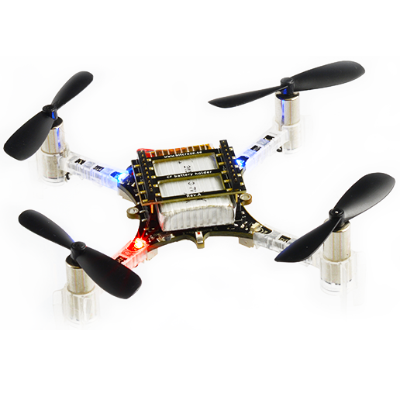Crazyflie 2.0
The Crazyflie line of micro quads was created by Bitcraze AB. An overview of the Crazyflie 2 (CF2) is here: https://www.bitcraze.io/crazyflie-2/

Quick Summary
The main hardware documentation is here: https://wiki.bitcraze.io/projects:crazyflie2:index
- Main System-on-Chip: STM32F405RG
- CPU: 168 MHz ARM Cortex M4 with single-precision FPU
- RAM: 192 KB SRAM
- nRF51822 radio and power management MCU
- MPU9250 Accel / Gyro / Mag
- LPS25H barometer
Flashing
After setting up the PX4 development environment, follow these steps to put the PX4 software on the CF2:
Grab source code of the PX4 Bootloader
Compile using
make crazyflie_blPut the CF2 into DFU mode:
- Ensure it is initially unpowered
- Hold down button
- Plug into computer's USB port
- After a second, the blue LED should start blinking and after 5 seconds should start blinking faster
- Release button
Flash bootloader using dfu-util:
sudo dfu-util -d 0483:df11 -a 0 -s 0x08000000 -D crazyflie_bl.binand unplug CF2 when done- If successful, then the yellow LED should blink when plugging in again
Grab the Firmware
Compile with
make crazyflie_default uploadWhen prompted to plug in device, plug in CF2: the yellow LED should start blinking indicating bootloader mode. Then the red LED should turn on indicating that the flashing process has started.
Wait for completion
Done! Calibrate via QGC
Wireless
The onboard nRF module allows connecting to the board via Bluetooth or through the proprietary 2.4GHz Nordic ESB protocol.
- A Crazyradio PA is recommended.
- To fly the CF2 right away, the Crazyflie phone app is supported via Bluetooth
Using the official Bitcraze Crazyflie phone app
- Connect via Bluetooth
- Change mode in settings to 1 or 2
- Calibrate via QGC
Connecting via MAVLink
- Use a Crazyradio PA alongside a compatible GCS
- See cfbridge for how to connect any UDP capable GCS to the radio